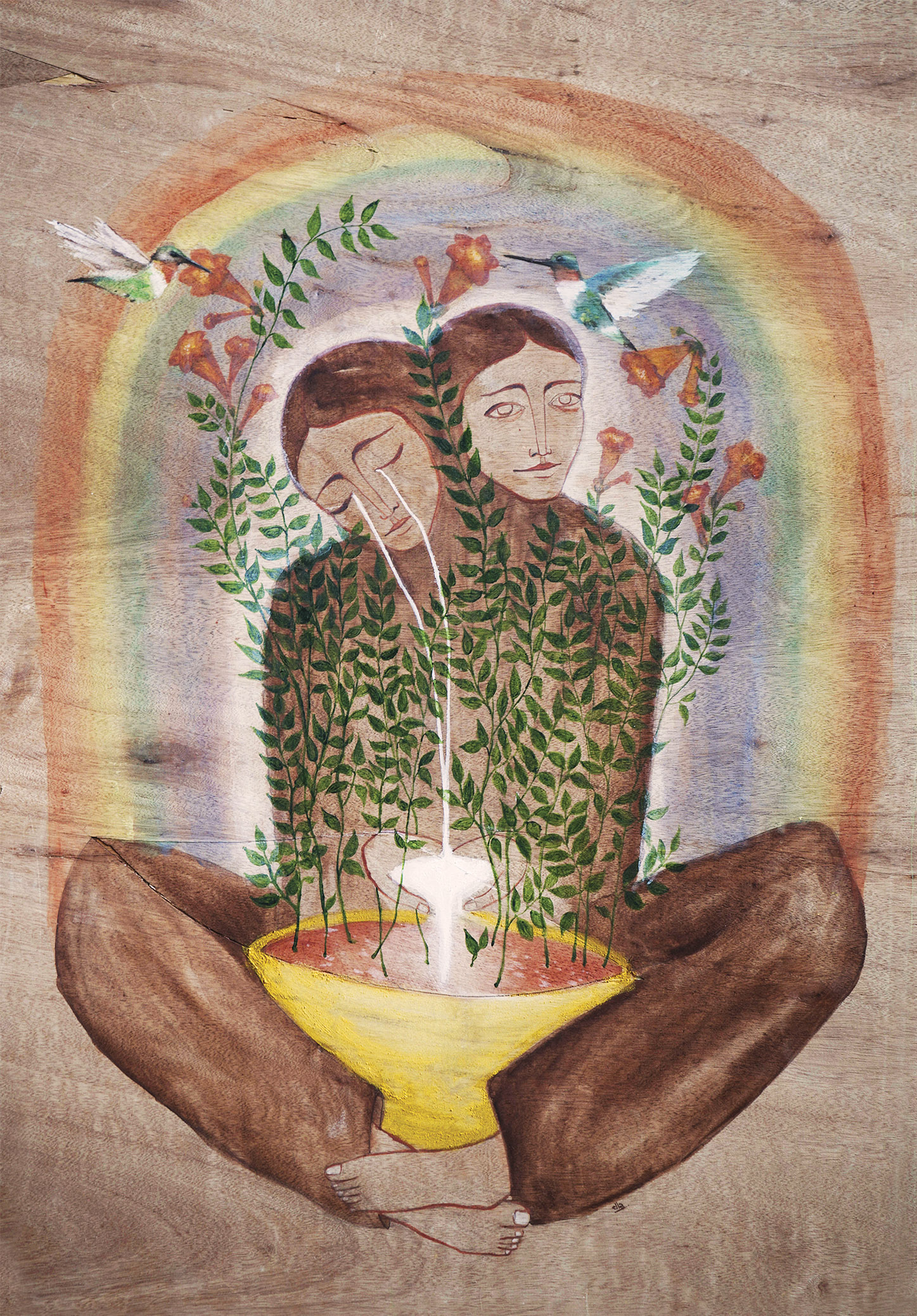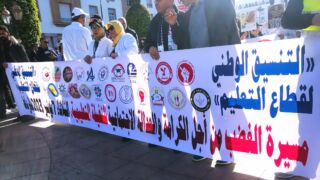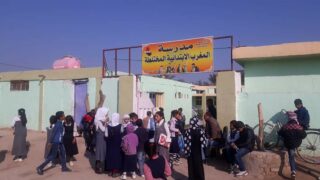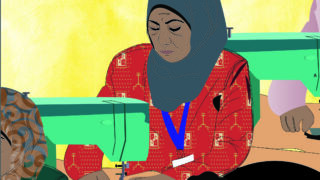
This publication has benefited from the support of the Rosa Luxemburg Foundation. This text may be reproduced in part or in full, provided the source is acknowledged.
I descended, accompanied by my guide, down the spiraling road that led to the village of Ain Zarqa on the outskirts of Tetouan in northern Morocco. We arrived on a Friday. It was about 1 pm when we found the market almost empty of its women, even though they constitute the majority of vendors there. They carry their vegetables and other products from rural areas to the market, usually in the early morning or at dawn. Meanwhile, most men go to the city to work on construction sites.
Right next to the mosque, we encountered a lovely organized café, the shades of which promised a refreshing coolness on that hot spring day. I greeted the young man leaning on a sofa in the middle of the café, which was noticeably empty of customers at this hour. I asked him about the land belonging to ethnic communities in the area and where I could find some of its owners. He answered immediately: "Here. I am one of them." I sat in front of him, and the ramified conversation about the apparently hot topic began to flow uninterruptedly right there and then. When I asked him about the shares of women in the ethnic lands in the area, he said that women did not have any problem with that. Then he called his sister Wafaa.
Wafaa, a thirty-year-old woman, is a blonde peasant whose features resemble many other women in the area. Her beautiful facial features sometimes take on soft expressions and sometimes stern ones. She has gone through a lot, yet she holds her ground. She smiles when she talks and purses her lips when mentioning difficult times. However, she is far from desperate, as she takes literacy classes at the village mosque, to undo what was a “destiny” for all village women. She is also admirably patient and resilient in the face of the harshness of life and the lack of money.
What are Sulaliyya lands?
“Al-Aradi al-Sulaliyya” or ethnic communities' lands represent the highest concentration of available land in Morocco, which is why their issue raises many critical political, economic, and social questions. The total area of these lands is 15 million hectares, out of the 71 million hectares that make up the area of Morocco. Per official statistics, the number of ethnic communities is more than 4,600, comprised of about 10 million rights-holders out of the 37 million inhabitants of Morocco. The highest percentage of ethnic communities' lands is in the southern desert (Errachidia, Zagora, Guelmim, etc.).
Ethnic communities' lands are those owned by tribes or clans belonging to certain ethnic groups bound by customary or tribal ties. They are held collectively, and their proceeds are distributed among their members (1). They are lands exploited by the first ancestor of the ethnic genealogy, around which the children and grandchildren gathered. Preceding any modern law, ethnic communities' lands had been subjected to tribal customs until recently. These lands are collective, undivided, and inalienable. They can either be assigned in shares allocated to rights-holders or not assigned and operated on behalf of the community. However, there are exceptions to this rule. Some lands have been disposed of either because they are related to investment projects specified by law or with other projects that took the land by defrauding the law.
The Sulaliyyate movement is unprecedented in Morocco. Historically, women had no access to land, whether collective or privately-owned. In general, the Sulaliyyate ceded their share to their male relatives so as not to be excluded from the family and the tribe. Male family members and tribal leaders thus felt threatened by the new demands of women.
Pastoral lands constitute more than 85% of the total area of communal lands. They are exploited by those with rights in housing, grazing, and farming so that everyone who cultivates barren land from the collective lands benefits from it. No one can dispute him as long as he is the one who reclaimed it.
The phenomenon of ethnic communities' lands resulted from the conditions that prevailed in pre-colonial Morocco, the prevalence of a semi-nomadic lifestyle, constant mobility, and the permanent state of war between tribes. All of this reduced the social value of personal property. The tribes wished to preserve their cohesion and avoid the fragmentation of their ancestral lands by creating collective ownership of land that is passed on from generation to generation under the supervision and control of the community, which stands as an impenetrable fortress against any foreign attempt to own them. Under this system, no one can sell or donate these lands. Moreover, if the father dies, land shares are traditionally passed down to male family members. If he has no sons, his brothers or uncles inherit his share. These customs did not, in most cases, recognize women as heirs and excluded them from compensation after giving up land ownership.
How the Sulaliyyate movement started
The Sulaliyyate women's movement is unprecedented in Morocco. Historically, women had no access to land, whether collective or privately-owned. In general, the Sulaliyyate ceded their share to their male relatives so as not to be excluded from the family and the tribe. Male family members and tribal leaders thus felt threatened by the new demands of women.
Ethnic communities' lands are those owned by tribes or clans belonging to certain ethnic groups bound by customary or tribal ties. They are held collectively, and their proceeds are distributed among their members. They preceded any modern law and had been subject to tribal customs until recently.These collective lands are undivided, and their revenues are distributed to male heirs only, per custom.
Ethnic communities' lands represent the highest concentration of available land in Morocco. The total area of these lands is 15 million hectares, out of the 71 million hectares that make up the area of Morocco. Per official statistics, the number of ethnic communities is more than 4,600, comprised of about 10 million rights-holders out of the 37 million inhabitants of Morocco.
The Sulaliyyate movement began in 2007 with women belonging to tribes that deprived them of their right to the usufruct of their fathers' lands under the pretext that they might marry strangers (from outside the clan). Thus, all women were deprived of their rights. The women began to flock periodically to the capital, Rabat, to pursue their daily struggle. Most of them did not receive an education of any kind. However, injustice was a strong motive for their demands to be made public with the support of the Democratic Association of Moroccan Women (known by its French acronym ADFM). ADFM was the most supportive civil society institution, credited with uniting the Sulaliyyate women and helping push their struggle forward.
The women raised many slogans during their vigils, including: “Is the land of the ancestors for sons and not for daughters?”, “My fight for my land is my right of my land,” “Oh ruler, oh judge! Grant me the right to my land.” During the process, women focused on moral recognition, which, in their view, is more crucial than material rights. In her interview with Assafir Al-Arabi (2), ADFM’s chairperson Saida Idrissi said that the ADFM adopted two approaches: the first related to women, and the second related to the external environment, i.e., public opinion and decision-makers.
In 2013, Morocco's Supreme Scientific Council (acting as a Fatwa Council) affirmed that the Sulaliyyate had the right to benefit from the revenues of the communal lands just as the men. It also stressed that depriving women of material and in-kind rights is unhealthy and that the past customary pretexts are no longer acceptable.
This issue was resolved in 2019 when the parliament passed Law 62-17, affirming the law’s supremacy over customs. The law stipulated that members of ethnic communities, both men and women, can obtain usufruct of all community properties to which they belong and that both genders have access to the representative bodies of their communities. It also stipulated that women can obtain, like men, compensations for real estate transactions in the lands of Sulaliyyate groups, whether by a partnership, lease, or assignment (assignment contracts are waiver contracts that allow for assigning land to a party outside the ethnic community.) It is carried out by consent for the benefit of the state, public institutions, and other ethnic groups after approval by the Tutelary Council of the ethnic community.
About the success of the Sulaliyyate women, Saida Idrissi said: “For the first time, women benefit from equality with men in terms of land distribution and compensation for land use. At first, men refused to put women on the list of beneficiaries and strongly resisted this. However, with the intervention of the Directorate of Village Affairs, the responsible body, and its supervision over the process of distributing rights to beneficiaries, most of the women benefited.”
During the distribution of plots of land to the Sulaliyyate women in an ethnic community in the Kenitra Region (within the area of the fertile Midwest lands), great joy accompanied the arrival of about 1,500 women. Their statements beamed with an elation which was impossible before. In a reportage on this occasion, Mahjouba Mhamda said: “My happiness and the happiness of women at being given their share of land is indescribable. Finally, I got my right and proved my identity and citizenship after getting justice.”
Hajiba Hrour, one of the 1,500 women who received plots of land or compensation, said: The most crucial thing in the process is men's recognition of the rights of Sulaliyyate women. Until recently, they totally refused to recognize our rights, but now we see some men accompanying their daughters and sisters to get their rights. Haddum Benzina, from the same area, breathed a sigh of relief when she said: “After ten years of struggle and frequent visits to the administrative departments in the capital with limited means, we have finally been redressed after a grave injustice. Our male brothers were getting their rights and ours. Now, we have obtained full equality with them (3) ."
In 2013, Morocco's Supreme Scientific Council (acting as a Fatwa Council) affirmed that the Sulaliyyate had the right to benefit from the revenues of the communal lands just as men. It also stressed that depriving women of material and in-kind rights is unhealthy and that the past customary pretexts are no longer acceptable.
Not only has this movement gained legal rights for women, but it has also generated new female leadership. Currently, nearly 30 women sit in the representative bodies of their communities (female deputies), which were previously exclusive to men. Their numbers will increase in line with the promulgation of the new law on the management of collective lands. Roqia, from Gharb Region, said: “As the first Sulaliyyate woman to run for the deputy position, I faced enormous difficulties. But the hardest part was the requirement to produce 12 male tribe witnesses to support my candidacy. Again, I had to fight for gender equality in the witness group, and I won the battle. It was a matter of principle because I could not accept this systematic exclusion of women.”
Thus, the Sulaliyyate movement led to the emergence of new leadership, the recognition of equal citizenship rights, and the admittance of women from humble backgrounds into official bodies. It also developed women's ability to work collectively to influence, protect the remaining lands, and adopt new methods of distributing the usufruct.
Does the law do them justice?
In her interview with the researcher (4) about the law issued in 2019 regarding the administrative Tutelary over ethnic groups and the management of their property, Rabea Naciri, one of the founding members of the ADFM, said that the law had a "positive effect on Sulaliyyate women, because, for the first time in history, they are recognized as right-holders. Moreover, the door has been opened for them to access the management and administration bodies.”
However, this recognition had been “accompanied by preconditions that made it impossible for women to obtain their rights consecrated in the law," Rabea Naciri said. She added: "Among them is the residency that was set as a precondition for members of the ethnic groups to benefit from lands. It is worth knowing that women are the first to leave the community either because of marriage or lack of opportunities, which is the main reason for depriving them of their rights in communal lands.” It is worth noting that the residence requirement also applies to men, but women, in general, pay the bigger price of this precondition.
The Sulaliyyate movement led to the emergence of new leadership, the recognition of citizenship rights, and the abilities of women from humble backgrounds in dealing with officials. It also developed women's ability to work collectively to influence, protect the remaining lands, and adopt new methods of distributing the usufruct.
The difficulty, on the other hand, is due to the "criteria related to granting ownership of barren plots of land belonging to ethnic groups to their members." "In fact, ethnic groups considered granting the ownership of any piece of land to those who reclaimed it and acquired it by custom as a prerequisite for owning agricultural lands. It is a precondition that led to excluding Sulaliyyate women for decades and putting them outside the list of beneficiaries of the ethnic groups' property so that they cannot own any of the reclaimed lands that could become personal property in specified cases. ” (5)
However, the new law established women's equality with men in terms of benefiting from the communal land inherited from the mother, father, or husband without attaching any preconditions to it.
Rabea Naciri said: “The law recognized women as part of ethnic groups. However, Article 4 stated that ethnic groups could dispose of their properties according to prevailing customs, which do not conflict with legal texts. Why does the law return to prevailing norms? The second observation is the absence of the consecration of equality, with many loopholes that made equality in several articles a non-binding formula. As long as the text contains loopholes from the beginning, there will be loopholes in applying the law, and tribal customs will remain dominant in managing communal lands. As long as the law is not strict enough to abolish the unjust customs and achieve the equality women sought in the face of the stiff resistance of the patriarchal tribal mind, many Sulaliyyate women will continue to suffer from exclusion and deprivation to the present day.”
About the challenges facing women on the ground to break the norms, with the presence of cases in which the ethnic group did not accept the implementation of the law, Rabea Naciri said: "The main challenge is to continue defending the Sulaliyyate cause in Morocco through the National Committee for Sulaliyyate Women, which was recently formed by representatives of Sulaliyyate women from different regions. That was done with the support of the ADFM to respond to the needs of the new legislative context. The committee's tasks are to "follow up the process of activating the law to ensure the protection of women's rights on an equal basis with men."
For their part, the authorities in charge talk about burglary and illegal access to the property. They said it was done either by the rights holders acquiring the property or others forging documents or because the administration facilitates this by complicity. But no one is excused for his ignorance of the law! There are about 185,000 hectares used illegally, compared to 120,000 hectares that are legally exploited. Women fall victim to this situation much more than men.
Testimonies of Sulaliyyate: Where is my right?
Mennana (6), from Mehdia in the Gharb Region, said: “I am a widow, with a family of six children and no financial resources. I was convinced that God wanted it that way. My feelings of injustice were exacerbated on the eve of Eid al-Adha in 2007. My brother received 270,000 dirhams as compensation for the transfer of land and bought the most expensive sheep without paying attention to the needs of my family. Since then, I have sworn to take back my rights and those of my sisters, and that was how it started.”
Fatima, from Meknes Region, said: “Right after my father died, my brothers asked me to renounce my rights, following up on the ancestral example of the women of the tribe. When I dared to ask them why the answer was: ‘this is how things work in the tribe. The woman is not even entitled to privately-owned lands, and now you raise the question of her right to collective lands.’ To claim my right, I spent two years staying all day outside the door of caïd (representative of the Interior Ministry at the local level) without daring to enter because I was afraid that my family, informed of my attempt, would accuse me of having brought shame and dishonor on them.”
The challenge that the ADFM faced in helping Sulaliyyate women, according to Rabea Naciri, was to clearly formulate their demands and build a unified movement to achieve their goals themselves. About this, Mennana, who is one of the Sulaliyyate, said: “These acquired abilities have made us credible. The men of the tribe and the local authority, who made fun of our demands, take us seriously now because they know we can win. They see us on television and in the newspapers, and that counts.”
Hajiba said: “Without collective action and acquired knowledge, none of us could have obtained our rights. When we had to meet the local authorities, we were prepared for what to say and the questions to ask. It was the only way for them to listen and respect us .” (7)
The law recognized women as part of ethnic groups. However, Article 4 stated that ethnic groups could dispose of their properties according to prevailing customs, which do not conflict with legal texts. Why does the law return to prevailing norms? As long as the text contains loopholes from the beginning, there will be loopholes in applying the law, and tribal customs will remain dominant in managing communal lands.
Concerning the social effects of depriving Sulaliyyate women of their rights to benefit from communal lands, Rabea Naciri said: “Depriving women of their rights to benefit from the properties of ethnic groups and the associated opportunities have led to their failure to integrate into the economic and social process. It has further deepened their vulnerability and thus impoverished them. Moreover, the exclusion of women from accessing the communal land under the pretext of prevailing norms has widened the gap and perpetuated discrimination between women and men within the ethnic groups. That left most women with a deep sense of ‘hogra’ - feelings of injustice and humiliation - which was the reason for the launch of the Sulaliyyate movement in Morocco to demand recognition of women as rights holders and the establishment of equality between women and men in all rights granted to members of ethnic groups .”(8)
They are not on the same boat
During my visit to the village of Ain Zarqa, Wafaa’s statement that women in her area did not suffer from land ownership problems like the Sulaliyyate women surprised me. She and the other women in her area inherit according to the law, i.e., half of the brother's share like all types of inheritance. Whether women marry into the tribe or not, the land remains in their name, and they have the right to use it in whatever way they find fittings.
However, Wafaa suffers from a different problem, shared by her tribe’s members, which is their inability to sell the land. "We are poor and have only the morsel of our day. If we get sick one day, how will we buy medicine while we have no savings but land? Circumstances may force us to sell it in times of crisis instead of leaving it to the ‘Sulala’ (ethnic group) to seize it," she said.
Souad Boulaish, an MP from a nearby area, commented on the issue of Sulaliyyate women in the north by saying: “The struggle for a law providing for gender equality in terms of benefiting from communal lands was not as active in the north as it was in the west, center, and south.” “Communal lands have greatly decreased in the area because of the real estate mafia that took possession of lands by circumventing the law that prevents their sale,” she added. About whether Sulaliyyate women benefited from selling or ceding land to strangers illegally, Souad said: "Some of them may have benefited, but only very slightly. Some do not know anything about the law, nor the distribution or ownership of land."
The content of this publication is the sole responsibility of Assafir Al-Arabi and Rosa Luxemburg Foundation cannot accept any liability for it.
Translated from Arabic by Sabry Zaki
Published in Assafir Al-Arabi on 20/06/2022
1- Dr Muhammad Khairy: “Communal Lands between Continuity and Extinction,” Lawyers Journal of the Safi Bar Association, issue No. 2, p. 35
2- Telephone interview with Saida Idrissi in May 2020.
3- A reportage for Hespress website entitled: "For the first time in Morocco... Sulaliyyate women benefit from the land of their fathers." https://www.youtube.com/watch?v=9m8YoE1N8YA
4- Telephone interview with Rabea Naciri, May 2022.
5- Al-Akhbar newspaper, interview with the Director of Rural Affairs at the Ministry of the Interior, Abdul Majeed Al-Hankari, October 15, 2019. https://bit.ly/3bdG4Ip
6- In a report on the testimonies of Sulaliyyate women presented by Ms. Rabea Naciri, who witnessed the Sulaliyyate struggle and led it to this day. https://mipa.institute/8462
7- From the interviews conducted by the Democratic Association of Moroccan Women with ten Sulaliyyate women in 2018
8- Rabea Naciri: “The Moroccan Sulaliyyate Movement: A Story of Exclusion and Empowerment,” a paper published as part of a report issued in partnership between the Moroccan Institute for Policy Analysis and the Baker Institute for Public Policy. https://mipa.institute/8462






